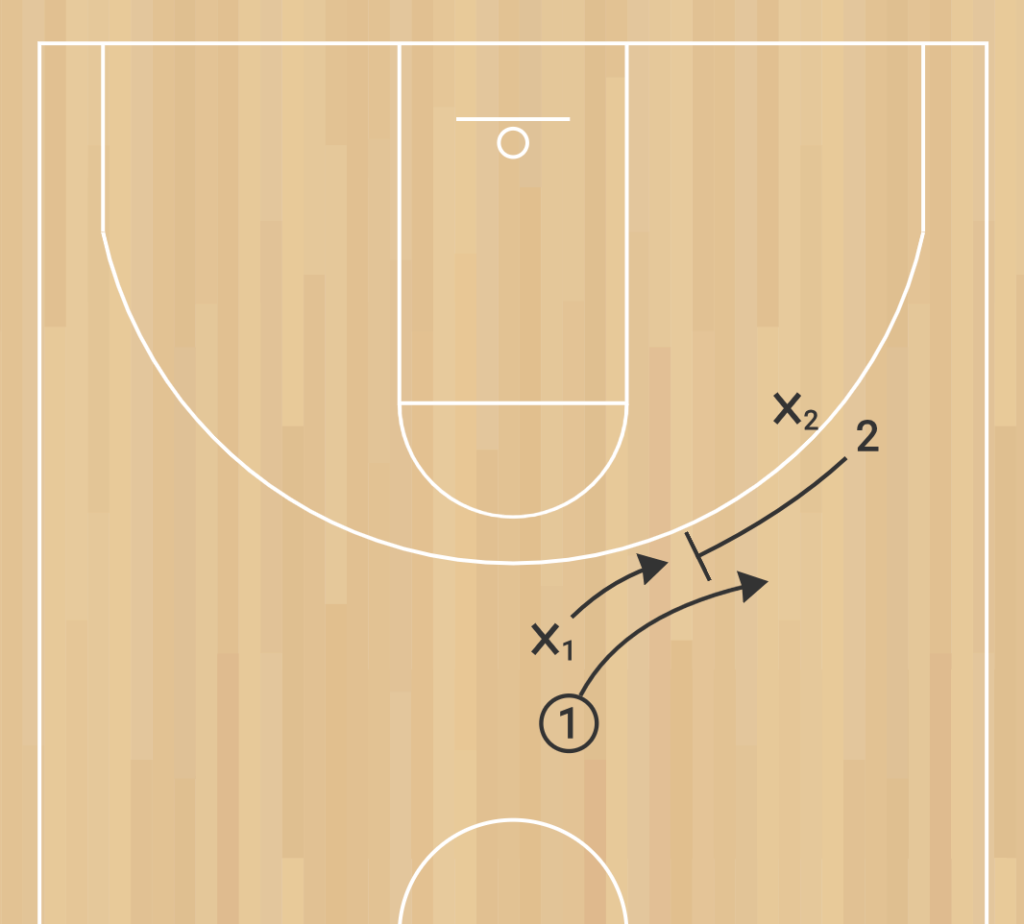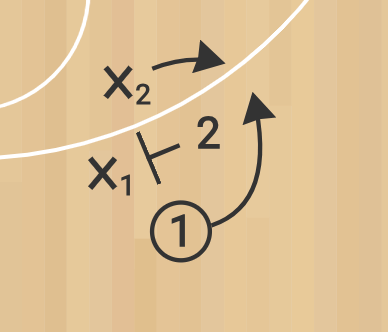Hedging, in basketball, is a strategy used by a defense to navigate a screen. It’s a pretty simple concept. A little visualization, and you should be able to recognize hedging in a game and understand why it’s valuable.
Now, I don’t want to get too deep here without first making sure that you have a firm grasp of the concept of ‘screening’ in basketball. You don’t need to be an expert, but you should be able to identify a screen before we talk about hedging. If you need a quick primer, here you go. It’s also really helpful if you understand the pick and roll game here.
But yeah, if you’re caught up on screening, we can get to work. We’ll walk you through how a basic basketball hedge works. Afterwards, we’ll dig into the various types of basketball hedging, when hey might be useful, and some of the details of how to introduce hedging to your team.
How a Basketball Hedge Works
Put yourself in a defender’s shoes…
You’re guarding your matchup. They don’t have the ball so you’re mostly looking to contain them and disrupt passing.
The ball handler approaches. Your matchup jumps to set the screen on the ball handlers defender.
Let’s say it looks a little something like the diagram here. You’re X₂ and you’re guarding 2. 2 is trying to screen X₁ to give ① a little room to operate.

So what do you do? You’re stuck in this weird formation, trying to figure out what your opponents are trying to pull. Let’s freeze right there for a second…

Four players, four different perspectives, countless possibilities. We can see that ① has the opportunity to accept the screen from 2, ditching the defender. If the handler accepts the screen, they might use the opportunity to drive for the basket or fade back a little and squeeze off a perimeter shot.
Where the hedge comes in is against that driving threat.
If ① makes the move to drive towards the basket, X₁ is now on the chase. To stay with their matchup, X₁ needs to get around the screen. They can either go ‘under’ the screen (on the basket side) or ‘over’ the screen (to the outside).
Either way X₁ is at a disadvantage. A decent screen will cause the defender to lose a step, or more, in pursuit of the ball handler.
So now, what if X₂ (that’s you) steps away from their matchup and into the path of the ball handler, like so…

Now ① has to hesitate. They’ve escaped their defender for a moment, but now they have to figure out how to get around you on the fly. That’s the hedge. You’ve just dropped a hedge. Sick!
Okay, but the real trick of it is that you have to jump back to your matchup! You’re not supposed to stick with ①. You just want to interrupt their path long enough to cause the hesitation that allows your buddy (X₁) to catch up. As soon as you get that hesitation, recover to your matchup.
That’s why hedging is a great counter to the screen and roll…
The Hedge vs. the Pick and Roll
The pick and roll plays on the dynamic between players with two different skillsets, usually an unstoppable big and a maneuverable guard. Use the weight of the big to take up space and give the guard space to get cruising downhill. With the big following right behind, you’re a handoff away from switching gears again completely.
A defense is probably going to do their best to put a quicker matchup on your guard and a bigger, stronger matchup on the big. But if the offense can create a mismatch in coverage on the screen, you have an even greater advantage.

Let’s go back to that hedge diagram. If X₂ decides to switch and just stay with ①, you’re probably stuck with a bigger, slower player defending a quick, maneuverable guard while your smaller defender is guarding a big ole roller.
With a good hedge, your X₂ takes a step out, taking up enough space to force the ball handler to hesitate and give X₁ a chance to catch up, then quickly recovering to guard 2.
You don’t lose your matchups. You maintain coverage.
Types of Hedging in Basketball
You can already kinda see that there are plenty of subtle choices to make when you deploy a hedge. Some language has evolved to point to those choices and kinda nudge them into classification.
Most of this language describes the positioning of the defender relative to the screener. Are they closer to the basket than the screener or closer to half-court? Are they opening up distance that can be exploited? There are other factors at play, but this positioning takes center focus.
Unfortunately, as you’ll find with a lot of basketball terminology, there are some issues. Terms are often used flexibly and vary from region to region. You’ll find a lot of subtle variations of the same thing under different names.
This can cause frustration, but I’ll walk you through as much of this as possible as I understand it. Let me know if you use a different term and where you encountered it. And while it doesn’t really matter what terms you choose to use, if you’re putting this in action, it is important to make sure your team is all in agreement on the terminology.
Soft vs. Hard Hedging
Digging deeper into this topic, you’ll start to encounter references to soft vs. hard hedging. This is a call to the level of pressure placed on the ball handler off of the screen. A hard hedge indicates a more aggressive approach. A soft hedge, more subtle.
Hard Hedging
To execute a hard hedge, you want to jump hard off of your defender when they set the screen and meet that ball handler head on with the goal of completely stopping their drive.
You should be over the screen here (closer to half-court than the screener) and you’ll probably spend a little extra time with the ball handler before jumping back to your matchup (2-3 seconds). Some coaches like to use 2-steps as a reference to describe just how long to stay on the ball. If successful, this style will force a pass or set the handler off of their path to the basket.
Because you’re really sticking with that ball handler, this can sometimes look like a double team or even a trap. Coach K has even been known to refer to this as a ‘fake trap’. Considering he’s known as a horns set practitioner, he’s plenty familiar with this move.
In the case that you do elect to stay in the double team and make a true attempt at a trap, this is known as a ‘blitz’ hedge. You’re likely leaving your roller wide opened here but it may be worth it in the right circumstance.
Soft Hedging
A soft hedge would would mean the opposite approach. Fall back a little, letting the handler come to you.
This will put you under the screen (closer to the basket than the screener) and while you’re not applying as much pressure straight away, you’re less committed and more able to adjust with the next movement.
A softer hedge could help avoid situations where the handler gets shifty and blows you by, while still slowing them up enough to give their defender a chance to catch up and allowing you to return to your matchup more quickly.
You also want to be wary of giving up enough room for the handler to ‘split’ the hedge. This is when the recipient of a screen is able to shake you enough that they can split right between you and the defender.
The split is obviously a riskier choice for the handler. But if you’re just out there waiting for them to complete the screen, they may spot this and take advantage. If they can pass you against your balance like that, they could get a situation that has both them and the screener on the right side of both defenders.
The soft hedge can sometimes be called a ‘drop’ hedge and the concept is sometimes blended in with drop coverage.
Flat Hedging
This is something right in-between. The screener’s defender sets up even with the screener, parallel with the baseline, their feet pointed towards half-court. This is something like the quintessential hedge. Like, if you asked a robot to drop a hedge, this is what they would come up with.
I’ve also seen this referred to as a ‘catch’ hedge, a ‘level’ hedge or a ‘touch’ hedge, the latter being a reference to a system of maintaining arms distance to that screener that you’re matched with as you try and manage the ball handler.
Should I go with a Hard or Soft Hedge?
This will largely depend on athleticism. If your defender can beat the ball handler and keep up with the screener, the hard hedge is an option. It’s just a somewhat more demanding take on an already challenging technique.
But you also want to be aware of shooters. If the ball handler is a proficient shooter, they’ll have a chance here to avoid dribbling into you altogether and just squeeze off an open shot.
Fronting vs. Backing
When to use Hedging in Basketball
Hedging is a simple enough concept that it should be a part of any defenders arsenal. Used effectively, it can be a great strategy against the pick and roll.
Hedging involves the defender quickly moving to block the offensive player’s path to the basket, forcing them to either choose a different route or take a contested shot. Hedging is an effective way to prevent dribble penetration and can be used as a strategy to force the offensive player to take a difficult shot or to pass the ball away from the basket. By utilizing hedging, defenders can disrupt the flow of the offense and prevent easy baskets.
Considering that hedging is a technique intended to derail the on-ball screen, it’s most effective against offensive sets that involve a lot of screening. That’s assuming your team has the athleticism to pull off a good hedge.
Now, for example, if you’re looking at a team that runs a lot of horns offense, hedging might be a good option. Horns is largely built around screens at the high post. If you can shut down that action, you can slow the opposing offense.
You also want to look at hedging when an opponent has quick guards who can drive to the basket. This may not always be effective because you may be jumping a less effective guard onto this athletic player, but it can serve to slow them down a little.
Weaknesses of Hedging in Basketball
Executed efficiently, hedging can be monstrously effective. But in order to do that, you need the right footwork. The dance of temporarily switching coverage can be intricate and confusing. So if your players aren’t athletic and well-prepared, hedging is not going to work.
This technique is also a bit less effective against the pick-and-pop where the ball handler dishes to an open shooter off of the screen. If you’re facing a team with good shooting, particularly good shooting from those bigs who will most often be setting screens, think twice about relying on hedging to shut down offense.
In this context, this style of play where the screener rolls to a perimeter shooting position as opposed to driving for the basket, is sometimes called a ‘short roll’. But the screener here can also elect to drop a pass from here instead of taking the shot, so it’s not limited to great shooters. It’s particularly effective against a hard hedge where the screener is allowed to distance themselves a little more from their assigned defender.
And obviously if the opposing team isn’t running screens at a high rate, the hedge isn’t going to come in handy, so there’s that.
How to Counteract Hedging in Basketball
The first thing you’ll want to look at if your offense is getting slowed down by hedging is to just lay off the ball screens. You can’t hedge what doesn’t exist. Shift your offense towards perimeter play and passing.
You can also lean into the pick-and-pop. Run plays that get your best shooters mixed up around that screen so the ball handler has options for an outside play as opposed to being forced to drive through that hedge. A great shooting big can completely dismantle a hedging system.
When to use a Hedge in Basketball
Hedging can be used in a variety of different situations. One of the best times to use hedging is when the offense is setting up. By hedging at the beginning of the play, the defense can disrupt the offense’s progress and force them to make a different decision. Hedging can also be used when the offense is in transition or in half-court sets. In transition, the defender can hedge the ball handler and prevent them from making a pass or scoring a basket. In half-court sets, the defender can hedge the ball handler and force them to make a different decision.
Alternatives to Hedging
Drop Coverage – This is something like an extra soft hedge. As the screener’s defender, you would hop way back, likely around the free throw line and setup to guard both your match and the ball handler. The goal here is to put pressure on shots near the basket.
Ice Defense – This is more dependent on the on-ball defender. The idea here is to reject the screen entirely, forcing the ball handler to break towards the sideline. This can also get very similar if not indistinguishable from what’s called a ‘weak’ hedge where the on-ball defender pushes the ball handler to their weak side. The difference being that a weak hedge is typically closer to the center of the court.
Conclusion
Hedging is an important concept to incorporate into your defensive strategy. It will come in handy. And when applied in the right situation, it can shift the tide of a game, improving defensive positioning, reducing foul risk, and creating turnovers. By understanding how to properly utilize hedging, teams and players can improve their positions defensively.
You can see here how hedging can prevent the offensive player from rolling to the basket after a pick-and-roll. Hedging should slow down the ball handler and give their defender a chance to get around the screen and catch up to them.
